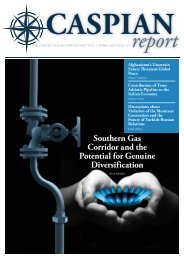You also want an ePaper? Increase the reach of your titles
YUMPU automatically turns print PDFs into web optimized ePapers that Google loves.
NINO KALANDADZE<br />
58<br />
become comprise a key part of the<br />
West’s plan for implementing its energy<br />
security concept.<br />
A. EUROPEAN ENERGY SECURITY<br />
I. INTRODUCTION<br />
The ongoing crisis in Ukraine has<br />
made the West, and especially the<br />
EU, rethink its strategy toward Moscow.<br />
Once again Western governments<br />
are questioning Russia’s reliability<br />
as a partner in international<br />
affairs. Energy security is high on<br />
the EU agenda. The crisis is unlikely<br />
to be resolved any time soon, and<br />
Kremlin’s threats to cut off Ukraine’s<br />
gas supply, unless it pays the price<br />
set by Moscow, are increasingly loud.<br />
History is repeating itself. Similar<br />
gas disputes have characterised the<br />
recent past, carried out by Moscow<br />
against its neighbours, including<br />
Georgia, 1 Belarus, 2 and Ukraine. In<br />
the latter case, several Central and<br />
Western European countries were<br />
also left without gas supply. 3 Today,<br />
again, talks on how to negotiate with<br />
Russia are topping the agendas in<br />
the EU’s national parliaments. Risks<br />
to Europe’s energy security are<br />
becoming more and more urgent,<br />
given that approximately 50% of<br />
Russia’s supply to the West is still delivered<br />
through Ukraine, making up<br />
a significant proportion of EU’s annual<br />
gas consumption. Against this<br />
background, Western policy makers<br />
are powerfully aware of the need for<br />
a common strategy to diversify Europe’s<br />
energy supply sources. Even if<br />
currently it seems unrealistic to substitute<br />
the Russian supply in full, an<br />
effective alternative must be found at<br />
least to replace the volumes threatened<br />
by the prolongation of the Russian<br />
– Ukrainian crisis.<br />
II. HISTORICAL BACKGROUND<br />
AND CHALLENGES OF<br />
DIVERSIFICATION<br />
Access to natural resources such as<br />
hydrocarbons has for decades represented<br />
one of the major challenges<br />
for international security and stability.<br />
So far, there seems to be no clearalternative<br />
to substitute fossil energy,<br />
excluding nuclear energy with the<br />
latter requiring huge financial investment<br />
and bearing high political costs.<br />
Thus gas and oil remain the preferred<br />
energy sources for a major part of the<br />
world economy. 4 According to a 2013<br />
survey, EU member states are collectively<br />
the world’s largest energy im-<br />
1.<br />
January 2006, two blasts shut down the main pipeline supplying Georgia with Russian gas, leaving the country without gas<br />
during one of its coldest winters. The Georgian government classified the attacks as deliberate action against Georgia.<br />
The view that this was done deliberately by Russia is substantiated by the fact that explosions took place in the Russiancontrolled<br />
North Ossetia, bordering Georgia’s then breakaway South Ossetia (fully occupied by Russian military forces),<br />
suspiciously coinciding with the scandalous discovery and public handover of Russian spies by the Georgian government.<br />
Finally, the attacks were preceded by gas disputes Russia against Moldova and Ukraine, providing further credence to this<br />
assumption. (For further discussion see Victor Yasman, Russia: “Is Georgian Gas Crisis Evidence of Moscow’s New Energy<br />
Strategy Radio Free Liberty, January 2006.<br />
2.<br />
Russia vs. Belarus gas disputes stretched out over a decade, emerging in 2004 alongside other Russia-Belarus disputes<br />
that were to follow almost every year, including gas cut-offs and disputes. Largely, it was understood as a politically<br />
motivated move on behalf of Russia, as Gazprom hoped to gain control over Beltransgaz and of its 6,000 km of pipelines,<br />
and thereby of the gas transit route delivering gas to Europe. (For further discussion see Chloe Bruce, fraternal Friction or<br />
Fraternal fiction: The Gas Factor in Russian-Belarusian Relations, The Oxford Institute for Energy Studies, March 2005.<br />
3.<br />
David Gow, “Russia-Ukraine Gas Crises intensifies as all European Supplies are cut off”, theguardian.com, Jan 2009. http://<br />
www.theguardian.com/business/2009/jan/07/gas-ukraine<br />
4.<br />
International Energy Outlook 2013, US Energy Information Administration, http://www.eia.gov/forecasts/ieo/nat_gas.cfm,<br />
see also “Recent trends in the Global Energy Oil & Gas Economy”, IISS – Oberoi Lecture, IISS, 14 August <strong>2014</strong>, http://www.<br />
iiss.org/en/events/events/archive/2013-5126/august-1e98/recent-trends-in-global-energy-1218










